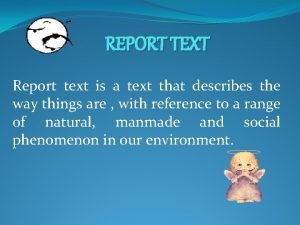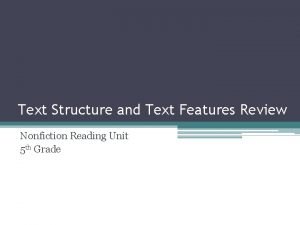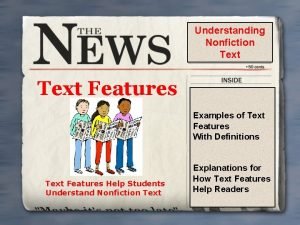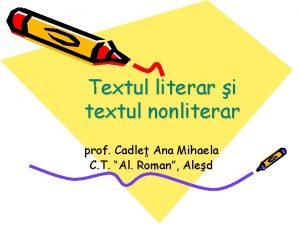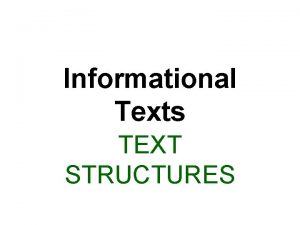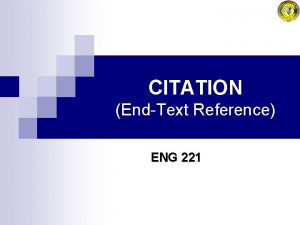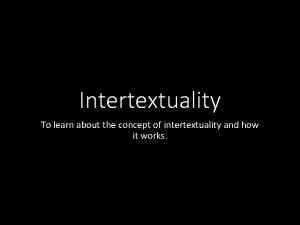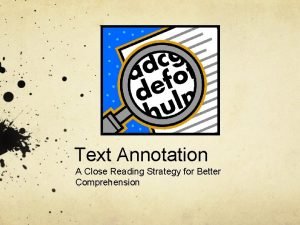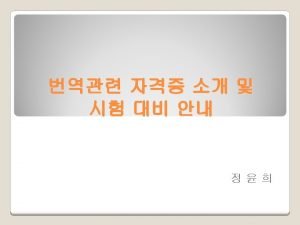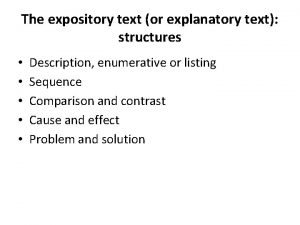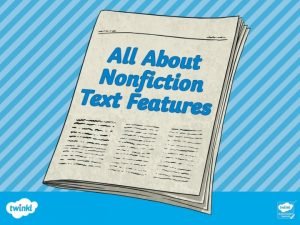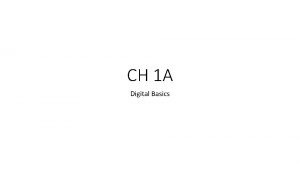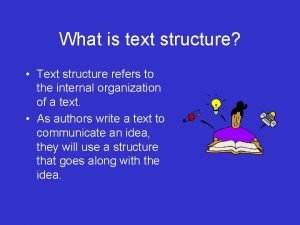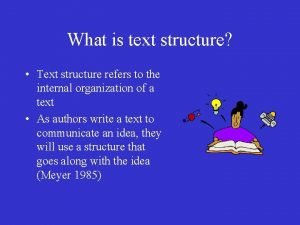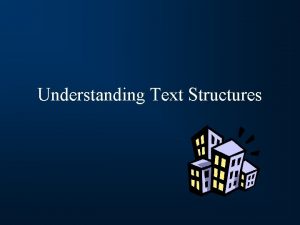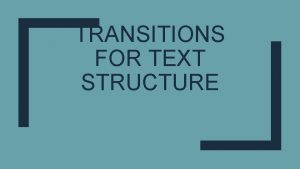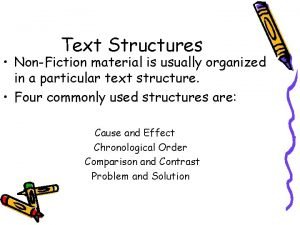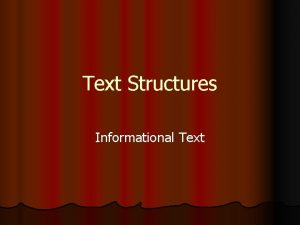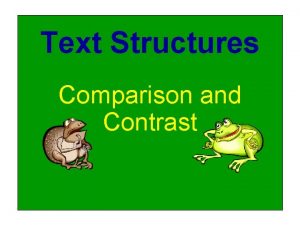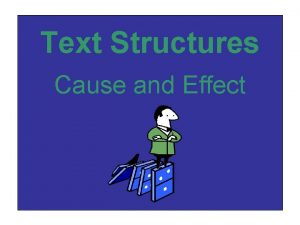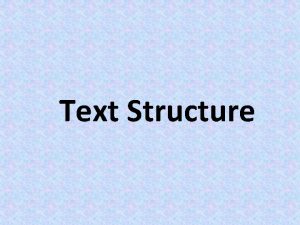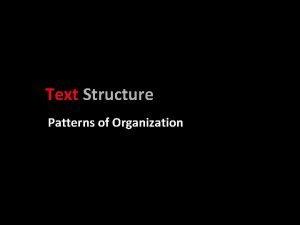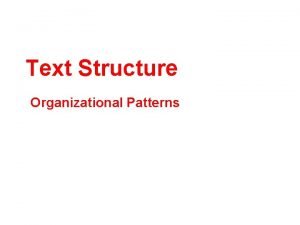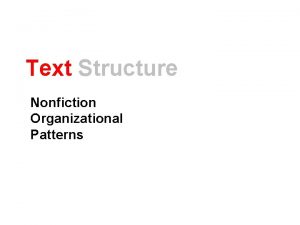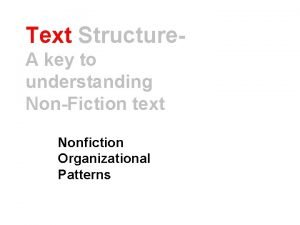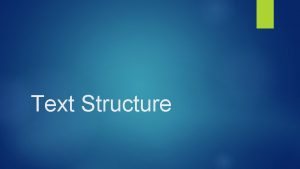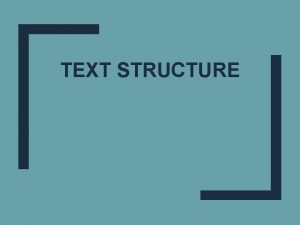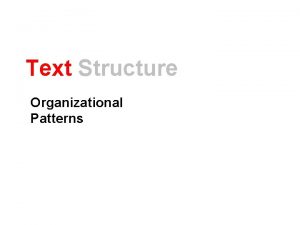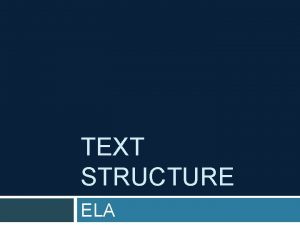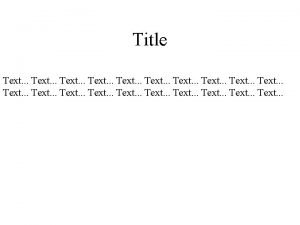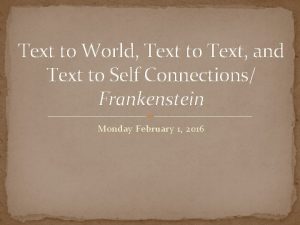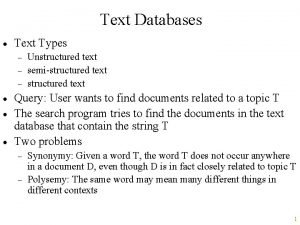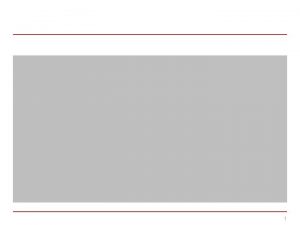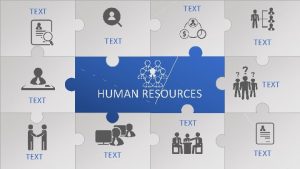TEXT STRUCTURE What is text structure Text structure



































- Slides: 35

TEXT STRUCTURE

What is text structure? Text structure is how information is organized in a passage The structure can change multiple (many) times in a passage

Types of Text Structure There are eight (8) common types of text structure: Cause and Effect Chronological Order Compare and Contrast Order of Importance Problem and Solution Sequence/Process Spatial/Descriptive Definition

Cause and Effect The results of something are explained. What is a cause? Something that gives rise to an action What is an effect? A result of an action

Cause and Effect With a partner create a list of cause and effect signal words. Be prepared to share with the class.

Signal words for cause/effect: Because, since, consequently, this led to…so, if…then, nevertheless, accordingly, because of, as a result of, in order to, may be due to, yet, for this reason, not only…but, also, due to, on account of, resulting

Cause and Effect With your neighbor, identify the cause and effect in the passage. You have 45 seconds. Becky Smith was invited to go to see “Breaking Dawn” with a group of her friends. Becky’s mom told her she could see the movie, but only if she cleaned her room and washed the dishes. Becky was so focused on picking out the perfect outfit that she forgot about her mom’s rule. Because Becky did not do her chores, she was not allowed to go the movie.

Cause and Effect Cause Becky did not do her chores. Effect Becky was not allowed to go to the movie.

Chronological Order Information is organized in order of time. With a your neighbor, create a list of signal words.

Chronological Order/Sequence Signal Words: First, second…, not long after, next, then, initially, before, after, finally, following this, in the process of

Chronological Order Jack and Jill ran up the hill to fetch a pail of water. Jack fell down and broke his crown and Jill came tumbling after.

Compare and Contrast Two or more things are described Their similarities and differences are discussed/analyzed.

Compare and Contrast Using a Venn Diagram (illustrated below), you will have 3 minutes to identify the similarities and differences of something. You will only be using facts—not opinions!

Compare and Contrast Write brief paragraph that explains the similarities and differences in your Venn Diagram. Highlight/underline your signal words Be ready to share.

Compare and Contrast Signal Words Different from, same as, similar to, similarly, as opposed to, instead of, however, compared to/with, as well as, either…or, but, on the other hand, on the same token, likewise, on the contrary

Order of Importance Information is expressed as a hierarchy or in priority Either least important to most important or vice versa (Most important to least)

Order of Importance Create a paragraph in which you describe the least and most horrible things you could do on a date. Highlight your signal words You have 5 minutes. Be prepared to share your ideas.

Order of Importance Here are three worst things that you can do on a date. First, you could tell jokes that aren’t funny and laugh really hard to yourself. This will make you look bad. Worse though, you could anger your date. One bad “joke” may cause your date to yell at you, thus ruining the evening. But the worst thing that you can do is to appear slovenly. By not showering and properly grooming, you may disgust your date, and this is the worst thing that you can do.

Order of Importance What are the least and worst things you could do on a date? Least: Tell really bad jokes. Worst: Don’t shower before the date.

Signal Words: Central, principal, chief, major, main, key, primarily, significant, finally, lastly, most important

Problem and Solution A problem is described and a response or solution is proposed or explained.

Problem and Solution Read the following passage. Identify the problem and solution with your neighbor. Write down your answers on a scrap piece of paper. You will have 2 and a half minutes.

Problem and Solution The volume in the hallway after lunch is an increasing problem. Loud students in the hallway disrupt the learning of those in class. Therefore, the teachers should enact a silent hallway policy to protect the learning of all students.

Problem and Solution What’s the problem? Students are too loud in the hallways. What’s the solution? Teachers should enact a silent hallway policy.

Problem/Solution Signal Words Problem, the question, is, a solution, one answer is, need, difficulty, dilemma, challenge, issue, answer, propose, suggest, indicate, solve, resolve, plan

Sequence/Process Information is organized in steps. A process is explained.

Sequence/Process Take out a piece of paper for this activity. Activity: Marvin the Martian has just landed in Houston, TX. Marvin is rather hungry and really wants to eat a bowl of cereal with milk, but he doesn’t know how! Write out each step Marvin must take to properly prepare and eat a bowl of cereal. Underline or highlight your signal words. *You will have 2 minutes to write out these steps! Be prepared to share your answers.

Sequence/Process 1. 2. 3. 4. 5. 6. 7. 8. Get a clean bowl from the cabinet. Take out a clean spoon from the utensil drawer. Pick the cereal you want. Retrieve the milk from the refrigerator. Pour the cereal into the bowl, but don’t fill it up all the way! Pour the milk into the cereal, but don’t pour too much! Use the spoon to scoop out the cereal and milk and bring it to your mouth. Chew, swallow, repeat until the cereal is gone!

Sequence/Process Thank you, earthlings!

Sequence/Process Signal Words First, second…, not long after, next, then, initially, before, after, finally, following this, in the process of

Spatial/Descriptive Information is organized in order of space (top to bottom, left to right). Example: When you walk into my living room, my sofa and a bookcase is to your right. To your left are the stairs leading to the second floor. The second bookcase is directly in front of you. On top of the second bookcase is my navy teddy bear.

Spatial/Descriptive Now it’s your turn! Using spatial (space) clues, write a description of a place that you like to be. Highlight or underline your signal words Be prepared to share your responses. You have 2 minutes to complete your descriptions.

Spatial/Descriptive Signal Words Behind, next to, diagonally, horizontal, in front of, to the left/right of, for instance, for example, such as, to illustrate, most important, in addition, another, furthermore, also, to begin with.

Definition It is used to introduce, explain, and describe a word or concept. It has three parts—a term, a definition, and an example. Signal Words: Defined as, is, known, is used to mean, for example, to illustrate, for instance, such as

Closure With a neighbor, answer the following questions: What is text structure? What are the seven types? Pick two to explain to your neighbor. Which is the most challenging structure for you? *You will have 3 minutes. *Be prepared to share your answers!
 Making connections
Making connections Generic structure of report text
Generic structure of report text Text features
Text features Textbox text feature
Textbox text feature Text literar exemple
Text literar exemple Text to world connection examples
Text to world connection examples Text _____ in a nonfiction text is its organization.
Text _____ in a nonfiction text is its organization. End-text citation example
End-text citation example This is the modeling of a texts meaning by another text
This is the modeling of a texts meaning by another text Annotation symbols for close reading
Annotation symbols for close reading Language translation
Language translation Expository vs narrative
Expository vs narrative Linear text to nonlinear text
Linear text to nonlinear text Text analytics and text mining
Text analytics and text mining An expository text is a type of persuasive writing
An expository text is a type of persuasive writing Text analytics and text mining
Text analytics and text mining Different types houses
Different types houses Explanatory vs expository
Explanatory vs expository What text features are included in this text
What text features are included in this text Plain, unformatted text is sometimes called ascii text.
Plain, unformatted text is sometimes called ascii text. Text structure refers to
Text structure refers to Common text structures and transition words
Common text structures and transition words Text argumentative
Text argumentative Understanding text structure
Understanding text structure Whats a text structure
Whats a text structure Problem and solution examples english
Problem and solution examples english Structure of informational text
Structure of informational text Compare words
Compare words Difference between cake and brownie
Difference between cake and brownie Cause and effect text structure keywords
Cause and effect text structure keywords Text structure refers to
Text structure refers to Definition text structure
Definition text structure Spatial text structure
Spatial text structure Text structure and organisation
Text structure and organisation The best pb and j ever text structure
The best pb and j ever text structure Types of nonfiction text structure
Types of nonfiction text structure

